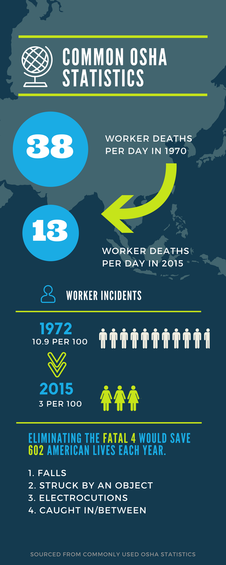|
For so many companies all over the globe, the worker safety story is the same: more and more resources are being spent, but it seems like it’s so hard to make any more improvement. Workers and safety managers both feel stuck – we’re better than we were, but we can’t seem to advance significantly more. From the food industry to manufacturing, oil and gas and beyond, all high-risk industries are facing the same new challenges in modern day worker safety.  Here’s what we know: We’ve improved a lot in the last 50 years. While any incidence of worker injury or death is too high, the improvements in the last 50 years highlight the focus that manufacturing, construction, and other high-risk industries have put on improving safety. Leading companies in these industries have invested time and resources improving safety cultures, prioritizing worker safety from the top down to proactively manage issues before injuries occur. Take these OSHA stats, for instance: In the 1970s, there were about 38 worker deaths each day, and there were 10.9 worker injuries and illnesses per 100 workers. Fast-forward to 2015: worker deaths dropped to 13 per day, and workplace illnesses and injuries were only three per 100 workers. That’s a significant shift in the right direction. We’ve reached a plateau. Yes, safety programs have been very successful in reducing incidents since the early 1970s. In recent years, however, reduction in workplace injuries has plateaued. It is a paradox which is difficult to explain. As American companies continue to spend billions on safety programs, injury rates over the past several years remain stagnant. Top-down safety initiatives will only take us so far. Despite growing expenditures and increased efforts, preventable injuries and deaths still occur. Why? The majority of investments fail to engage and empower the worker in the practice of safety effectively, and often use dated, analog processes. Top-down safety initiatives gave us 50 years of growth, but the last mile in injury reduction will have to be worker-powered and technologically relevant. Consider this scenario: Tom has worked in manufacturing for the same employer for over 20 years. He knows his job well and does it proudly. Tom has attended hundreds of hours of safety training and, like most of his co-workers, takes safety seriously. Recently, Tom was walking through the plant and noticed a safety hazard that he couldn’t resolve himself. Tom took the time to find the safety issue reporting box, document the problem and submit it. The next day, the hazard was still there. At lunch, several others mentioned that they had also seen the hazard. Tom was angry that this safety issue hadn’t been resolved. Tom wondered whether all of the training wasn’t just a waste of time. A few weeks later, Tom noticed another hazard, but he didn’t bother reporting it. It seemed no one was listening. It sometimes seems that companies are working so hard to establish a safety culture, that they miss opportunities to leverage the critical element of community. A management-driven safety culture operates top-down in a hierarchical manner. A worker-driven safety culture operates bottom-up, encouraging engagement and ownership. Worker-driven safety is a community of eyes and ears and problem-solvers who are committed to improving results. The good news is that Tom’s company can still build this type of culture, and so can yours. Here are three ways how: Capture the voice of the worker. Your workforce is a fantastic source of safety information. Experienced workers are on the front line in your facility and likely know how to identify and resolve most safety issues. Workers want to know that their employer is willing to invest in safety, and they also want the responsibility to help protect themselves and their co-workers. Effective safety programs don’t just offer information and training for employees, but rather create a two-way conversation for employees to be empowered and heard. Real-time information sharing. Your workforce is in the best position to identify hazards and eliminate them immediately, but only if they have the right tools in place. Sharing real-time information about existing and emerging safety hazards across your organization enables employees to respond quickly while still following critical process. Offering your workforce a better way to stay connected to the right resources is key, and that’s where technology comes into play. Leveraging wearable technology. In the age of constant connectivity, we can tap a mobile device to catch a ride, order dinner or chat with someone on the other side of the world. At Corvex, we envision an environment where real-time, meaningful safety information is shared between workers and management to improve safety and productivity. The Corvex Connected Safety™ platform utilizes proprietary hardware and software to enable real-time hazard identification and resolution, PPE management and safety communication, and worker engagement. Worker-powered safety is our vision. Remember Tom’s story? Now imagine he has a Corvex Cor-Link running the Corvex Connected Safety solution.The next time Tom notices a hazard, he simply uses his Cor-Link device to take a picture of the hazard, input some relevant info and notify the team. It takes less than a minute and just a few clicks. Tom can resolve the issue himself or submit it to a group of competent team members for resolution. At the next safety briefing, Tom gets a round of applause and feels like he made a difference. Author: Ted Smith, CEO of Corvex Comments are closed.
|

